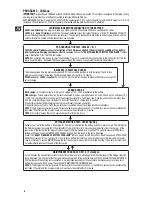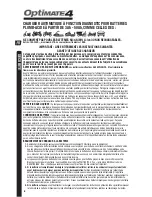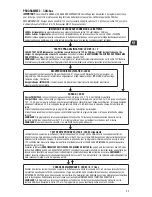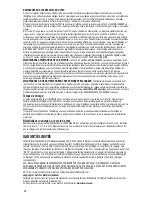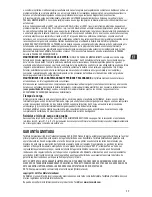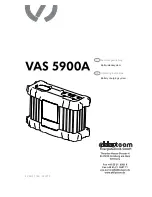
3
™
AUTOMATIC DIAGNOSTIC CHARGER FOR 12V LEAD-ACID BATTERIES
FROM 3Ah TO 50Ah, AS FOUND IN:
DO NOT USE FOR NiCd, NiMH, Li-Ion OR NON-RECHARGEABLE BATTERIES.
Input: 100-240V
maximum 0,27A. The maximum output current is 0,8A.
IMPORTANT: READ THE FOLLOWING INSTRUCTIONS BEFORE USING THE CHARGER
This appliance is not intended for use by persons (including children) with reduced physical, sensory or
mental capabilities, or lack of experience and knowledge, unless they have been given supervision or
instruction concerning use of the appliance by a person responsible for their safety. Children should be
supervised to ensure that they do not play with the appliance.
SAFETY WARNING AND NOTES:
Batteries emit EXPLOSIVE GASES - prevent flame or sparks near batteries.
Disconnect AC
power supply before making or breaking DC/battery connections. Battery acid is highly corrosive. Wear protective clothing and
eyewear and avoid contact. In case of accidental contact, wash immediately with soap and water. Check that the battery posts are
not loose; if so, have the battery professionally assessed. If the battery posts are corroded, clean with a copper wire brush; if greasy
or dirty clean with a rag damped in detergent. Use the charger only if the input and output leads and connectors are in good,
undamaged condition. If the input cable is damaged, it is essential to have it replaced without delay by the manufacturer, his
authorised service agent or a qualified workshop, to avoid danger. Protect your charger from acid and acid fumes and from damp
and humid conditions both during use and in storage. Damage resulting from corrosion, oxidation or internal electrical short-
circuiting is not covered by warranty. Distance the charger from the battery during charging to avoid contamination by or exposure
to acid or acidic vapours. If using it in the horizontal orientation, place the charger on a hard, flat surface, but NOT on plastic, textile
or leather. Use the fixing holes provided in the enclosure base to attach the charger to any convenient, sound vertical surface.
EXPOSURE TO LIQUIDS:
This charger is designed to withstand exposure to liquids accidentally spilled or splashed onto the
casing from above, or to light rainfall. Prolonged exposure to falling rain is inadvisable and longer service life will be obtained by
minimizing such exposure. Failure of the charger due to oxidation resulting from the eventual penetration of liquid into the electronic
components, connectors or plugs, is not covered by warranty.
BATTERY CONNECTIONS:
2 interchangeable connection sets are available, supplied with the charger is a set of battery clips for
charging the battery off-vehicle, the other connection set comes with metal eyelet lugs for permanent connection to the battery
posts, and re-sealable weatherproof cap on the connector that connects to the charger output cable. This connection set allows easy
and sure connection of the charger to maintain the battery on-vehicle. The resealable weatherproof cap is designed to protect the
connector from dirt and damp whenever the charger is not attached. Consult a professional service agent for assistance in attaching
the metal eyelets to the battery posts. Secure the connector with weatherproof cap so that it cannot foul any moving part of the
vehicle or the cable can be pinched or damaged by sharp edges. The in-line fuse in the eyelets connection set protects the battery
against such accidental shorting across positive and negative conductors. Replace any burnt fuse only with a similar new fuse of
15A rating.
CONNECTING THE CHARGER TO THE BATTERY
1.
Disconnect AC power supply before making or breaking DC / battery connections.
2.
If charging a battery in the vehicle with the battery clips, before making connections, first check that the battery clips can be
safely and securely positioned clear from surrounding wiring, metal tubing or the chassis. Make connections in the following
order: First connect to the battery terminal not connected to the chassis (normally positive), then connect the other battery clip
(normally negative) to the chassis well away from the battery and fuel line. Always disconnect in reverse sequence.
3.
When charging a battery out of the vehicle with the battery clips, place it in a well ventilated area. Connect the charger to the
battery: RED clamp to POSITIVE (POS, P or +) terminal and BLACK clamp to NEGATIVE (NEG, N or –) terminal. Make sure the
connections are firm and secure. Good contact is important.
4. If the battery is deeply discharged (and possibly sulfated), remove from the vehicle and inspect the battery before
connecting the charger for a recovery attempt.
Visually check the battery for mechanical defects such as a bulging or
cracked casing, or signs of electrolyte leakage. If the battery has filler caps and the plates within the cells can be seen from the
outside, examine the battery carefully to try to determine if any cells seem different to the others (for example, with white
matter between the plates, plates touching). If mechanical defects are apparent do not attempt to charge the battery, have the
battery professionally assessed.
5.
If the battery is new
, before connecting the charger read the battery manufacturer’s safety and operational instructions
carefully. If applicable, carefully and exactly follow acid filling instructions.
SAFETY
TM240-IN1-130322_113%.indd 3
13-03-21 4:58 PM






